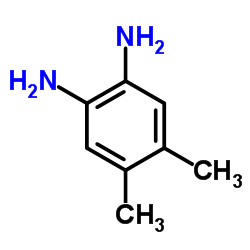2-amino-4,5-dimethylphenylamine

2-amino-4,5-dimethylphenylamine structure
|
Common Name | 2-amino-4,5-dimethylphenylamine | ||
|---|---|---|---|---|
| CAS Number | 3171-45-7 | Molecular Weight | 136.194 | |
| Density | 1.1±0.1 g/cm3 | Boiling Point | 279.6±35.0 °C at 760 mmHg | |
| Molecular Formula | C8H12N2 | Melting Point | 127-129 °C(lit.) | |
| MSDS | USA | Flash Point | 144.9±25.4 °C | |
|
The acute phase protein ceruloplasmin as a non-invasive marker of pseudopregnancy, pregnancy, and pregnancy loss in the giant panda.
PLoS ONE 6(7) , e21159, (2011) After ovulation, non-pregnant female giant pandas experience pseudopregnancy. During pseudopregnancy, non-pregnant females exhibit physiological and behavioral changes similar to pregnancy. Monitoring hormonal patterns that are usually different in pregnant m... |
|
|
Synthesis of new derivatives of 4-acylquinoxalin-2-ones with potential pharmacological activity.
Acta Pol. Pharm. 51 , 231, (1994) Some of new derivatives of 4-acylquinoxalin-2-one obtained in the reaction of N,N'-bis(chloroacetyl)-4,5-dimethyl-o-phenylenediamine with primary amines are described. Compounds were tested for their anti-HIV activity and as ligands for 99mTc. |
|
|
Ruthenium(II) arene anticancer complexes with redox-active diamine ligands.
Inorg. Chem. 48(19) , 9444-53, (2009) The synthesis and characterization of ruthenium(II) arene complexes of the general formula [(eta(6)-arene)Ru(XY)Z](+), where arene = p-cymene (p-cym), hexamethylbenzene (hmb), or biphenyl (bip), XY = o-phenylenediamine (o-pda), o-benzoquinonediimine (o-bqdi),... |
|
|
Development and validation of a liquid chromatographic method for the determination of ascorbic acid, dehydroascorbic acid and acetaminophen in pharmaceuticals.
J. Pharm. Biomed. Anal. 48(2) , 331-9, (2008) A reversed-phase ion pair liquid chromatographic method (RP-LC) for the determination of dehydroascorbic acid (DHA) and ascorbic acid (AA) and also acetaminophen, which is combined in pharmaceuticals, is proposed and validated. AA and acetaminophen were analy... |
|
|
Aspects of the release of superoxide by leukocytes, and a means by which this is switched off.
Environ. Health Perspect. 102 Suppl 10 , 43-4, (1994) Although great progress has been made in understanding the respiratory burst of leukocytes that produce superoxide (O2-), it is possible that a component or components, might have been overlooked. Furthermore, O2- production and its sequels, though cardinal i... |
|
|
Methoxatin (PQQ) in guinea-pig neutrophils.
Free Radic. Biol. Med. 17(4) , 311-20, (1994) PQQ, also called methoxatin, has been isolated from guinea-pig neutrophils. The organic cations diphenyleneiodonium (DPI) and diphenyliodonium (BPI) and the aromatic o-diamine 4,5-dimethylphenylenediamine (DIMPDA) sequester synthetic PQQ and inhibit its redox... |
|
|
Rapid and sensitive determination of the intermediates of advanced glycation end products in the human nail by ultra-performance liquid chromatography with electrospray ionization time-of-flight mass spectrometry.
Anal. Biochem. 424(2) , 187-94, (2012) The resolution of the intermediate advanced glycation end products (AGEs) in the human nail was carried out by the combination of 4,5-dimethyl-1,2-phenylenediamine (DMPD) derivatives and ultra-performance liquid chromatography with electrospray ionization tim... |
|
|
A simple fluorometric determination of vitamin C.
Chem. Pharm. Bull. 46(9) , 1474-6, (1998) A simple and accurate method for determination of vitamin C (ascorbic acid (AsA) and dehydroascorbic acid (DHA)) using 4,5-dimethyl-o-phenylenediamine (DMPD) was investigated. It was found that DMPD is a useful fluorescent reagent. The reaction product of DMP... |
|
|
[Products in the fluorometric reaction of purines with 4,5-dimethyl-o-phenylenediamine after oxidation using N-bromosuccinimide].
Yakugaku Zasshi 110(10) , 776-82, (1990) Twelve purines oxidized with 4,5-dimethyl-o-phenylenediamine (DMPD) was found to react with N-bromosuccinimide (NBS) to give fluorescent derivatives. In this paper, the identification of oxidation and fluorescent products have been described. In compliance wi... |
|
|
Bull. Korean Chem. Soc. 15 , 1122, (1994)
|